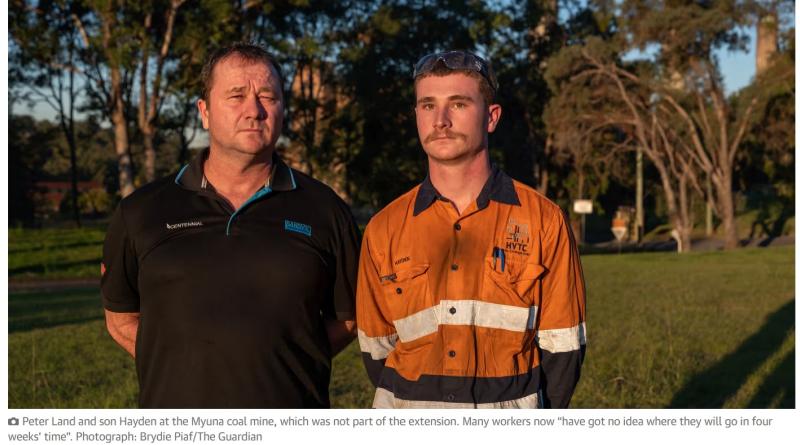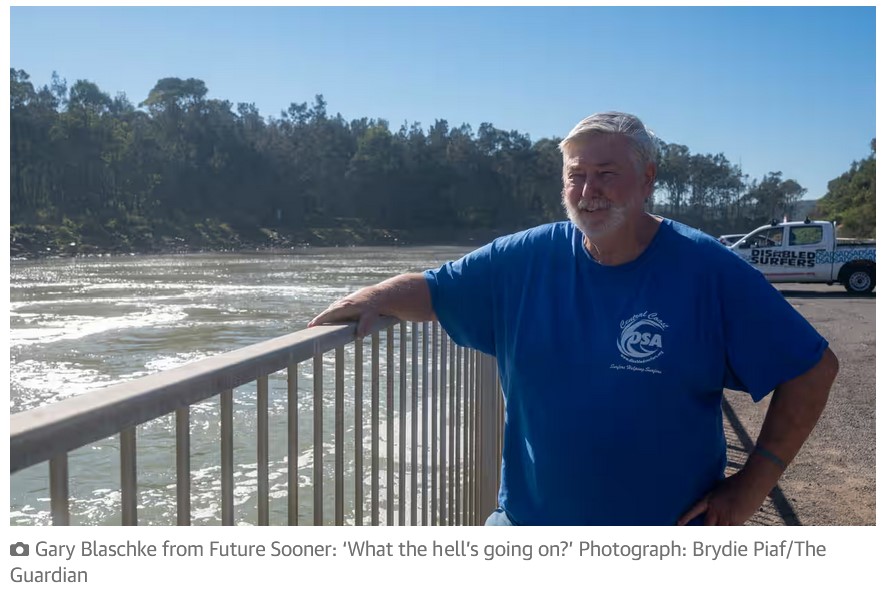‘People prefer that we’d never close’: Eraring lifeline a mixed blessing for a coal community in limbo

For Scott King, last week’s announcement by the New South Wales government to extend the giant Eraring power station for at least another two years was a mixed blessing.
“It’s certainly not the longevity that people were hoping for but it does give [us] breathing space,” says King, a plant operator who has worked 18 years at the nation’s biggest coal-fired power station. “Of course, people prefer that we’d never close.”
The owner, Origin Energy, tried to sell the 40-year-old plant back to the Coalition government in 2021 for $544m, according to documents revealed this week. When that gambit failed, Origin set an August 2025 closing date – seven years earlier than scheduled prior to the extension, dimming prospects for Eraring’s 230-odd employees.
Despite the uncertainty, King, who is a delegate with the Mining and Energy Union, says he knows of only one person who left the plant for another job. He cites a survey predicting workers leaving the sector would cop a 60% to 70% pay cut: “To face that is quite confronting.”
Eraring, which supplies one-fifth of NSW’s electricity, is now obliged to generate half that share – or 6 terawatt-hours a year – until August 2027. It may then run for another 20 months but without state support.
The period of limbo will linger for many in the Lake Macquarie region, including green groups who fear the legacy of Eraring’s 35m tonne coal ash dam, and authorities and firms working to prime the economy for a post-coal future in one of Australia’s fastest growing population centres 120km from Sydney.
‘On the scrap heap’
Intervention by the Minns Labor government may have granted Eraring a temporary reprieve but so far there is no reprieve for 1,000 workers at the two nearby coalmines.
Origin is negotiating with Centennial Coal over contracts expiring at the end of June. The Myuna mine has no other outlet for its coal, while Mandalong exports half its output and can’t lift shipments through Newcastle if the Eraring deal falls through.
Peter Land’s dad started work at Mandalong when it opened, and his 20-year-old son Hayden is now a first-year apprentice training for Myuna, making it potentially three generations supplying Eraring.
“They’ll essentially be thrown out on the scrap heap” even before their first year of training ends, Land says of his son and two other apprentices gathered at Myuna this week.
Miners had hoped the government would demand Eraring’s traditional mines also benefited from the extension. Instead, Mach Energy’s Mt Pleasant and New Hope’s Bengalla mines in the Hunter Valley look set to fill the void.
Myuna’s staff and many at Mandalong now “have got no idea where they will go in four weeks’ time”, Land says. Car loans and mortgages too will be in jeopardy.
Origin posted a 17-fold increase in profit and secured a deal for the state to absorb 80% of any Eraring losses – as much as $450m – for two years. It now wants to squeeze miners, says Belinda Giblin, lead organiser of the Collieries’ Staff & Officials Association.
“Do they have to have a social conscience and accept that there is a cost to doing business and [do] the right thing?” Giblin says.
An Origin spokesperson says negotiations with Centennial are “ongoing and we are hopeful of reaching an outcome. It would be wrong to imply a commercial outcome can’t be reached.”
Guardian Australia understands rival mines are offering prices Centennial will struggle to match. Government data estimated Myuna’s coal price as about $175/tonne and Mandalong’s $297/t, and officials say they won’t interfere with Eraring’s commercial decisions.
Other interventions – or their absence – will be closely watched by environmentalists.
Health and environmental risk’
Abigail Boyd, the Greens MP who initiated a 2019 upper house inquiry into remediation of coal ash dams including Eraring’s, says the government has a “conflict of interest within themselves”.
Tighter regulation of pollution entering the environment via smoke stacks or the ash dump will increase plant costs. The risk-sharing arrangement means taxpayers could be on the hook for much of any additional losses.
“These privatisation deals that were done by the previous [Coalition] government sentenced the people of the Central Coast to additional decades of health and environmental risk,” Boyd adds.
Had governments acted on the inquiry’s recommendations in March 2021, the health picture might have been clearer, says Gary Blashchke from Future Sooner, a local group.
One recommendation called on NSW Health to “immediately undertake an epidemiological assessment of the health of residents near coal ash dams to establish the health impacts of coal ash and publish by 31 December 2022”.
The Coalition government declined, saying NSW Health would instead “propose alternative study types which are better able to address the community’s health concerns”.
Blaschke, who underwent three years of immunotherapy after being diagnosed with non-Hodgkin lymphoma, says there has been little response from NSW Health or the Environment Protection Authority.
“We have 1142 kids in Wyong and Gosford hospital with chronic asthma [or] acute asthma,” he says. Separately, two children at the same preschool recently developed brain cancer and two teenagers died with spinal tumours.
“It sort of got me thinking, what the hell’s going on?” he says.

In 2017, the government examined the safety of eating fish and crustacea caught in Lake Macquarie, a common activity, particularly near the outlet canals for cooling water from Eraring and the Vales Point coal-fired power station.
The EPA recommends limiting crab consumption because of elevated levels of cadmium, a toxic metal. Selenium, lead and mercury are other contaminants.
An EPA spokesperson says the agency is “working on a comprehensive and independent assessment of environmental impacts of coal ash dams”. It expects to release its finding by mid-2024, including monitoring of the lake’s water quality.
Health minister Ryan Park said NSW Health was “working closely with partner agencies to assess the impact of this on the health of communities, and I look forward to reviewing their findings in due course”.
NSW Health commissioned a review of environmental data to determine whether people living close to power stations and coal ash dams “were exposed to potentially hazardous chemicals through air, water, soil or local fish and seafood”.
“The Department of Climate Change, Energy, the Environment and Water has prepared a draft report on possible pathways and likelihood of exposure to coal ash and other pollutants of concern,” the spokesperson said, adding the report would be subject to further community consultation when completed in coming months.
Coal ash needn’t remain in the landscape forever. It can be reused as an ingredient for concrete and road foundations, an economic activity encouraged by David Antcliff, director of development at the Lake Macquarie city council.
Planning restrictions often curb councils’ ability to grow but Antcliff says his region has “enough zoned land for housing for the next 20 years”. Rather, the council is desperate to access land for industry – such as for offshore windfarm developers – to generate jobs once the mines and power stations close.
“Mining lands is actually the big story here,” he says. These occupy thousands of hectares that “for decades and decades had provided a huge amount of economic prosperity … but that’s very much coming to an end and very soon”.
Complicated rules have slowed their repurposing, in some cases by two decades.
“It’s illogical for me to be approving development applications on virgin bushland and knocking it down when I’ve got disturbed industrial land next door that’s literally having trees grown on it,” Antcliff said.
The region’s “test case” is the Black Rock Motor Resort atop a former Rhondda underground colliery dormant since 1970, being developed by Tony Palmer.
The $95m race track, Australia’s second-longest at 5.25km, will have luxury accommodation, a function centre and provide more than 220 jobs when it opens in June 2026. Electric vehicles and innovative fuels will feature in the project.
“With all of the incentives that are thrown in the directions of the miners, there’s zero coming back over the fence to the developers that have a vision,” Palmer says. Attempts at seeking support are “just not worth the paper it’s written on and a waste of air”.






